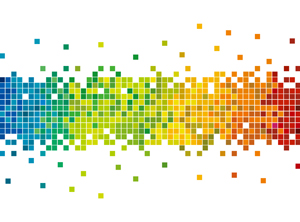A polarizing view

A pixel can be encoded with two different colors from a wide color palette using nanostructure arrays illuminated with orthogonally polarized light. © simon2579/iStock/Thinkstock
Through precise structural control, A*STAR researchers have encoded a single pixel with two distinct colors and have used this capability to generate a three-dimensional stereoscopic image1.
Figuring out how to include two types of information in the same area was an enticing challenge for Xiao Ming Goh, Joel Yang and their colleagues at the A*STAR Institute of Materials Research and Engineering. They knew such a capability could help a range of applications, including ultrahigh-definition three-dimensional color displays and state-of-the-art anti-counterfeiting measures. So they set about designing a nanostructure architecture that could provide more ‘bang for the buck’.
Having previously used plasmonic materials to generate color prints at the optical diffraction limit by carefully varying the nanostructure size and spacing, Yang thought polarization would be a promising direction to pursue. “We decided to extend our research to prints that would exhibit different images depending on the polarization of the incident light,” he explains.
The main challenge to overcome was the mixing of colors between polarizations, a phenomenon known as cross-talk. Goh and Yang trialed two aluminum nanostructures as pixel arrays: ellipses and two squares separated by a very small space (known as coupled nanosquare dimers).
Each pixel arrangement had its own pros and cons. While the ellipses offered a broader color range and were easier to pattern than the nanosquare dimers, they also exhibited a slightly higher cross-talk. In contrast, the coupled nanosquare dimers had a lower cross-talk but suffered from a very narrow color range.
Because of their lower cross-talk, the coupled nanosquare dimers were deemed better candidates for encoding two overlaid images on the same area that could be viewed by using different incident polarizations.
While the coupled nanosquare dimers’ color palette could be expanded by varying the width and spacing between adjacent squares in each nanosquare dimer, the ellipses were better for demonstrating the wide color range achievable.
Furthermore, the researchers used these pixel arrays to generate a three-dimensional stereoscopic image. They achieved this by using ellipses as pixel elements, carefully offsetting the images and choosing background colors that minimized cross-talk.
“Being able to print two images onto the same area and, further, generating a three-dimensional stereoscopic image opens up many new avenues for applications,” remarks Goh.
But the possibilities do not end there. Complex nanostructures, including circularly asymmetric shapes, offer many more options. “By employing additional circular polarizations, we could encode multiple images ― that is, not just two, but three or more images in a single area,” Goh explains.
The A*STAR-affiliated researchers contributing to this research are from the Institute of Materials Research and Engineering. More information about the group’s research can be found at the Plasmonic and Semiconductor Nanostructures Laboratory webpage.
Reference
Goh, X. M., Zheng, Y., Tan, S. J., Zhang, L., Kumar, K., Qiu, C.-W. & Yang, J. K. W. Three-dimensional plasmonic stereoscopic prints in full colour. Nature Communications 5, 5361 (2014). | article
Media Contact
All latest news from the category: Materials Sciences
Materials management deals with the research, development, manufacturing and processing of raw and industrial materials. Key aspects here are biological and medical issues, which play an increasingly important role in this field.
innovations-report offers in-depth articles related to the development and application of materials and the structure and properties of new materials.
Newest articles

A ‘language’ for ML models to predict nanopore properties
A large number of 2D materials like graphene can have nanopores – small holes formed by missing atoms through which foreign substances can pass. The properties of these nanopores dictate many…

Clinically validated, wearable ultrasound patch
… for continuous blood pressure monitoring. A team of researchers at the University of California San Diego has developed a new and improved wearable ultrasound patch for continuous and noninvasive…

A new puzzle piece for string theory research
Dr. Ksenia Fedosova from the Cluster of Excellence Mathematics Münster, along with an international research team, has proven a conjecture in string theory that physicists had proposed regarding certain equations….



